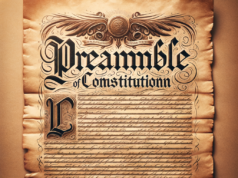
The 16th Amendment of the United States Constitution was ratified in 1913, giving Congress the power to levy and collect income taxes. The amendment reads, “The Congress shall have power to lay and collect taxes on incomes, from whatever source derived, without apportionment among the several States, and without regard to any census or enumeration.” The 16th Amendment had a significant impact on the United States, as it allowed the federal government to collect funds without having to rely on tariffs and excise taxes alone.
To fully understand the impact of the 16th Amendment, it’s important to examine why it was added to the Constitution. In the late 19th and early 20th centuries, the United States experienced significant economic growth and development. As individual wealth increased, so did the need for revenue to fund the country’s growing infrastructure and government operations.
Before the 16th Amendment, the federal government had limited power to raise revenue. Congress was only able to impose direct taxes, such as income taxes, through a process known as apportionment. This meant that taxes had to be distributed equally across the states based on their population.
According to the Tax Foundation, “The apportionment rule required that any direct taxes be distributed among the states based on population. This meant that, for example, if a state had 10% of the national population, it would be responsible for paying 10% of any direct national tax.” This made it difficult for Congress to raise significant revenue through income taxes, as the wealthier states would have to shoulder a greater share of the burden.
In addition, income tax laws at the state level were often confusing and inconsistent, with some states levying taxes on all types of income while others only taxed specific sources of income. The lack of consistency and clarity in state tax laws made it difficult for taxpayers to understand and comply with their tax obligations.
The 16th Amendment effectively removed these barriers to federal income tax revenue by granting Congress the power to levy taxes on all incomes, regardless of the source, without the need for apportionment. This allowed the federal government to create a more comprehensive and consistent income tax system that could generate a substantial amount of revenue.
One of the key benefits of the 16th Amendment was that it allowed the federal government to create a more progressive tax system. Prior to the amendment, the federal government relied primarily on tariffs and excise taxes, which tended to be regressive. This meant that lower-income individuals paid a larger share of their income in taxes than wealthier individuals.
The adoption of the 16th Amendment allowed the federal government to impose a more progressive tax system by taxing higher-income individuals at a higher rate. This approach was designed to ensure that those who could afford to pay more were shouldering a greater share of the tax burden.
“The ratification of the 16th Amendment opened the door for a more progressive tax system in the United States,” says Joseph Bishop-Henchman, Executive Vice President at the Tax Foundation. “Prior to the amendment, the federal government relied primarily on tariffs and excise taxes to raise revenue. This meant that lower-income individuals paid a larger share of their income in taxes than wealthier individuals. With income taxes in place, the U.S. could create a more equitable tax system that better reflects the ability of individuals to pay.”
One example of the impact of the 16th Amendment is the creation of the Internal Revenue Service (IRS), which is responsible for administering and enforcing the federal income tax system. Prior to the amendment, there was no centralized federal agency responsible for collecting and enforcing income taxes. This led to confusion and inconsistent enforcement of tax laws at the state and local levels.
“In the years following the ratification of the 16th Amendment, the federal government created the IRS to administer and enforce the federal income tax system,” explains Bishop-Henchman. “This allowed for greater consistency and accuracy in tax collection and enforcement, which has led to a more efficient and effective tax system.”
Another impact of the 16th Amendment is the way it has influenced state income tax laws. Prior to the amendment, states had limited power to impose income taxes, as any direct taxes had to be apportioned based on population. The adoption of the 16th Amendment allowed states to create their own income tax systems without having to rely on federal apportionment rules.
Today, all but nine states have some form of income tax. Each state’s tax code is unique, with varying rates, exemptions, and deductions. States have the power to set their own income tax laws, but they are limited by the federal taxation framework established by the 16th Amendment.
“The 16th Amendment gave states more power to tax income without federal interference,” says Bishop-Henchman. “Today, each state has its own income tax laws, but they must comply with federal tax laws and guidelines. This has led to a diverse array of state tax codes, with some states having high rates and others having no income taxes at all.”
One key feature of the 16th Amendment is that it provides Congress with broad authority to impose income taxes “from whatever source derived.” This means that there are few limits to the types of income that can be taxed at the federal level.
The 16th Amendment gives Congress wide latitude to tax all types of income, including wages, salaries, investments, and business profits,” explains Bishop-Henchman. “This has allowed for a comprehensive federal tax system that can generate a significant amount of revenue to fund government operations.”
Despite this broad authority, there are some limitations to federal income tax laws. For example, the Supreme Court has held that Congress cannot impose income taxes that are “direct” without apportionment. This means that Congress cannot impose taxes on the states themselves or on other forms of direct taxes that are not based on incomes.
The impact of the 16th Amendment extends beyond just income taxes. Its adoption represented a significant expansion of federal power and authority. Prior to the amendment, many Americans feared that the federal government was overreaching its power and infringing on individual liberties. The adoption of the 16th Amendment, along with the passage of other progressive reforms like the Sherman Antitrust Act and the Meat Inspection Act, helped to allay these fears and establish the federal government as a more powerful and effective force in American life.
“The 16th Amendment represented a significant expansion of federal power and authority,” says Bishop-Henchman. “It helped to establish the federal government as a more effective and efficient entity, capable of generating the revenue needed to fund critical government functions.”
The 16th Amendment is also unique compared to the tax systems of other countries around the world. Although many countries impose income taxes, the specific structures and rates of those taxes can vary widely. In some countries, income taxes are the primary source of government revenue, while in others they are less significant.
“Income taxes are a global phenomenon, but the specific structures and rates of those taxes can vary widely from country to country,” notes Bishop-Henchman. “In the U.S., income taxes are a significant source of federal revenue, but they are just one piece of a larger tax system that includes excise taxes, tariffs, and other revenue streams.”
One key difference between the U.S. income tax system and those in other countries is the degree of progressivity. The U.S. income tax system has traditionally been more progressive than those of many other countries, with higher-income individuals paying a larger share of their income in taxes.
“In some countries, income taxes are less progressive than in the U.S.,” says Bishop-Henchman. “This can be due to a variety of factors, including political and cultural differences, as well as differences in the structure of tax systems.”
Despite these differences, the 16th Amendment remains a key landmark in American history and a defining feature of the U.S. tax system. Its adoption allowed the federal government to create a more comprehensive and consistent income tax system that has helped to fund critical government functions and establish a more equitable tax system.
The Sixteenth Amendment provided for a uniform law regarding the collection of income tax on the national level. The introduction and passage of the Sixteenth Amendment would prove to be crucial, impacting the financial growth and economic standing of the United States.
The main concept of the Sixteenth Amendment is that under the new legislation, Congress would not need to apportion an income tax among the states or have it based upon the numbers produced by the Census. The Sixteenth Amendment would revise the previous Constitutional provisions regarding direct taxes and except income taxes on rent, interests, and dividends from those requirements as a result of the pollock v. Farmers’ Loan & Trust Co.in 1895. The Sixteenth Amendment would be ratified on February 3rd, 1913.
The Sixteenth Amendment reads, “The Congress shall have the power to lay and collect taxes on incomes, from whatever source derived, without apportionment among the several States, and without regard to any census or enumeration.” The new legislation created for Congress’ right to impose a Federal income tax, which was the subject of much change and, at times, confusion prior to the ratification of the Sixteenth Amendment.
The first income tax was imposed as a result of the Civil War, which was introduced in 1861. It consisted of a three-percent flat tax on incomes greater than $800. This would be changed a year later to introduce a graduated tax ranging from three to five percent on incomes over $600. All income taxes were considered to be indirect taxes and were imposed according to geographic uniformity. Direct taxes were required to be apportioned according to the population of the states.
Prior to the Sixteenth Amendment, the income tax system was an issue of dispute between farmers and those involved in industrial professions. The argument was that the low prices set upon for their farm products and the requirement to pay high prices for manufactured goods and products were unfair. Many farmers would form coalitions and organizations to introduce their tax platforms, consisting of a graduated income.
The Pollock v. Farmers’ Loan & Trust Co.case would declare that some income taxes were unconstitutional because they were not apportioned direct taxes. The case would determine that the source of income would be used in order to classify whether the income was direct or indirect, and thus, allowing for the definition of what kind of income tax would be levied. Income taxes on wages were not to be apportioned by the population numbers, while those on interests, dividends, and rent were.
The growing dispute prior to the case reflected the sentiment of the Government protecting industrial and financial markets by protecting the economic elite created by Industrialization. The Sixteenth Amendment would finally address and solve the dispute as to how income was to be taxed and under what determinations such income tax is to be considered to be properly enacted and enforced.
























